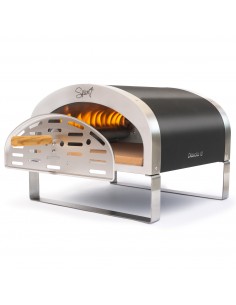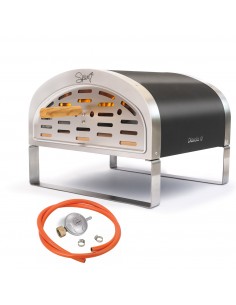- Spice
- Insights
- 26202 views
- 0 comments

What is refractory stone
The refractory stone is a type of ceramic material resistant to high heat, usually used for the construction of ovens, fireplaces, barbecues and other structures where high resistance to high temperatures is required. This material is able to withstand temperatures exceeding 1000 degrees Celsius without suffering structural damage, due to its ability to conduct heat in a very limited way.
What is clay stone
The clay biscuit, also known as a biscuit plate or pan, is a support for baking which is used to bake foods such as bread, pizza and desserts. It is a refractory clay dish cooked at high temperatures, which makes it heat resistant and able to maintain a constant temperature. The porous surface of the biscuit allows it to absorb excess moisture, preventing the food from sticking or becoming too moist during cooking. In addition, the surface of the biscuit is able to distribute heat evenly, ensuring even cooking and browning of the food.
Differences and uses for cooking
The main feature of casapulla biscuits is that they have low thermal conductivity and high porosity. They quickly absorb the moisture of the pizza dough and slowly release the heat. This makes them ideal for high / very high temperature cooking (450°, 500° and above) such as true Neapolitan pizza.
Refractory stones have low porosity and high thermal conductivity. For this reason they develop a more impact cooking, and ideal for temperatures that do not exceed 400° and a crunchy base (like Roman pizza).
Use in pizza ovens and cleaning
The baking stone and clay biscuit get dirty during cooking due to the accumulation of residues and impurities from the ingredients of the pizza, such as cheese, tomato sauce, oil and flour.
During cooking, these ingredients can burn on the surface of the stone or biscuit, forming a film of hard residues that are difficult to remove. Furthermore, the ingredients can infiltrate the pores of the stone or clay, promoting the formation of deposits of grease and impurities on their surface.
Additionally, repeated cooking on the same surface can cause residue to build up which can make the pizza stone or clay cookie less efficient at distributing heat and cooking the pizza.
It is therefore important to keep the surface of the refractory stone or clay biscuit clean and free of impurities to ensure uniform and crispy cooking of the pizza and to prevent the accumulation of residues which can compromise their efficiency in the long term.
Both the refractory stone and the clay biscuit require proper maintenance and cleaning to guarantee good cooking quality and prevent the accumulation of residues and impurities on their surfaces. Pyrolysis is one of the methods used for cleaning both materials, as described above.
Cleaning the stone / biscuit: things not to do
There are a few things that are important to avoid when cleaning your firestone or clay cookie to ensure its life and efficiency:
Do not use harsh cleaners: Harsh cleaners can damage the surface of your firestone or clay biscuit, making them less efficient at distributing heat and allowing residue to build up on their surface.
Do not immerse the refractory stone or clay biscuit in water: the water can penetrate inside the pores of the stone or clay, favoring the formation of cracks or fragments during subsequent cooking.
Do not use scrapers or abrasive objects to remove cooking residues: the use of abrasive objects can damage the surface of the refractory stone or clay biscuit, favoring the accumulation of residues on their surface and reducing their efficiency in heat distribution .
Do not use metal objects to handle the baking stone or clay biscuit: metal objects can scratch or damage the surface of the stone or clay, reducing their efficiency in cooking and promoting the accumulation of residues on their surface.
In general, it is important to use gentle, non-aggressive methods for cleaning your firestone or clay biscuit, such as cleaning with warm water and a damp cloth.
How to effectively clean the baking stone and clay cookie
The refractory stone being made of porous material, absorbs ashes and cooking residues. It is therefore completely normal that after a few uses it shows dark spots, they are nothing more than small residues of seasoning that have fallen on the stone and have been blackened by the operating temperature. As mentioned, this is completely normal and in no way affects the operation of the pizza oven or of the stone itself; indeed some even claim that an "aged" stone gives the pizzas a better flavor over time.
The only way to clean a refractory stone in the best possible way without compromising its functionality is Pyrolysis or the prolonged high temperature that generates a thermochemical organic decomposition. In this way, the high temperature will carbonize the absorbed food residues, releasing them in an easily removable powder form. Obviously pyrolysis in the true sense of the word is a complex operation as it should be done in the absence of oxygen, but below we will show you how to clean the stone with a similar system and in total autonomy with your pizza oven.
How to clean the refractory stone
Clean by rubbing the stone with a blunt spatula (spice steel palettes are ideal) and non-abrasive the visible excesses and in relief of carbonized residues on the stone such as mozzarella or other elements in relief.
Pass a cloth moistened with water only on the stone to remove the dust generated by the previous rubbing.
At this point it depends on what level of dirt the stone has accumulated on the surface and how clear you want to make it, you can simply turn on the oven at maximum power and let it go for about 45 minutes. If the stone is not particularly dirty, you must wait for the stone to cool and then wipe it again with a cloth moistened with water only to remove the dust generated.
Is the stone very dirty and needs more powerful pyrolysis?
Turn the stone!! This operation is quite simple and has the advantage of immediately having a stone / cookie as if it were new. Furthermore, turning it and placing the blackened part in direct contact with the lower heating element for a long time (each new use the heating generates pyrolysis which cleans it) thanks to the higher temperatures the stone will automatically clean itself over time, so that you can turn the stone again in the future and repeat the operation over time always having an acceptable stone.
Conclusions
Pyrolysis can be used for cleaning the firestone and clay biscuit used in electric pizza clamshell ovens.
In particular, the pyrolysis process eliminates accumulations of fat, food residues and other impurities that accumulate on the surface of the refractory stone or clay biscuit, making them difficult to clean with traditional methods.
To carry out the pyrolysis process, it is necessary to heat the refractory stone or clay biscuit at a high temperature (usually between 400°C and 500°C) for a period of time ranging between 30 and 45 minutes. This heating process in the absence of oxygen allows organic residues to be decomposed and burned, completely eliminating them from the surface of the refractory stone or clay biscuit.
It is important to note that pyrolysis must be done carefully and safely, using tools and equipment designed for handling the firestone or clay biscuit and for temperature control. It is also important to ensure that the pyrolysis process does not damage the firestone or clay biscuit, which can be brittle and sensitive to high temperatures.









Comments (0)
New comment